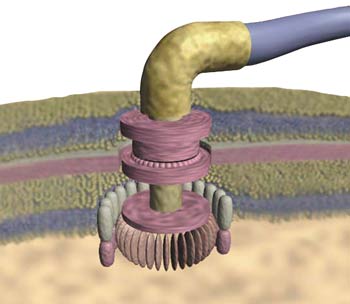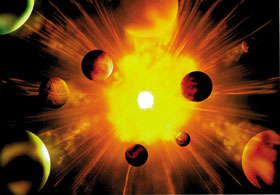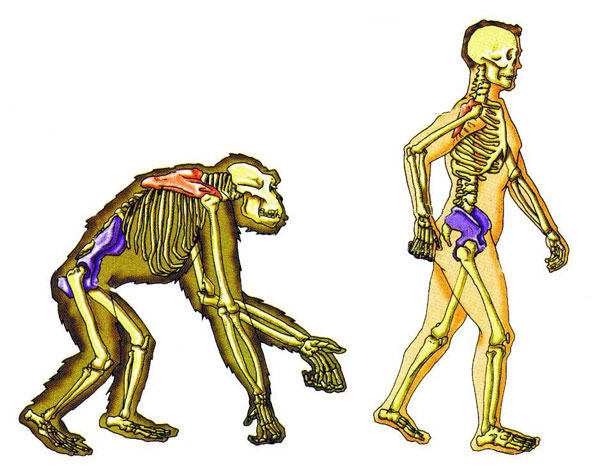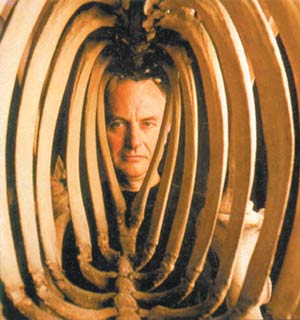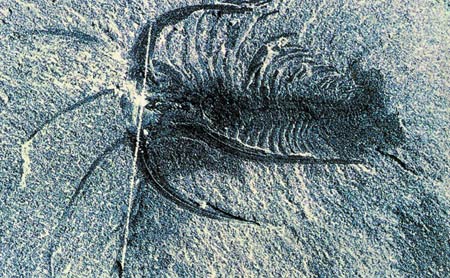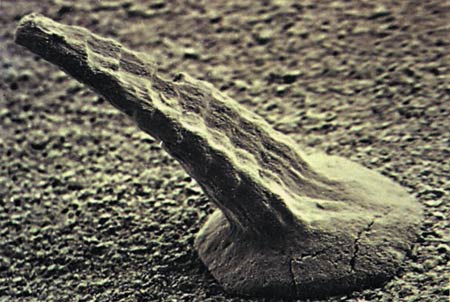Bigotry: The Dark Danger
The Evolution Impasse 1

DOWNLOAD THE BOOK
CHAPTERS OF THE BOOK
< <
3 / total: 11
BBacteria flagellum
Flagella, allowing bacteria to move in a fluid environment, attached to the membrane covering the bacteria’s cell surface, and their whiplike movement allows the bacteria to swim quickly from place to place. These flagella have long been known about, but only in the last 10 years has their structure been observed carefully, to the surprise of the scientific world. Contrary to what had been supposed, the undulation of the flagellum is not the result of a simple mechanism, but of a very complex organic motor. The bacterium’s flagellum is mechanically similar to electric motors. There are two main movements: a moving rotor and a non-moving stator. This organic motor is different from other systems that cause organic movement. The cell does not use the energy stored in it in the form of ATP molecules; it uses energy from acids in its membrane. The inner structure of the motor is highly complex: About 240 different proteins make up the flagellum, and these have been put in place with a perfect mechanical design. Scientists have determined that these proteins send signals that start and stop the flagellum, that their articulations allow movement at the atomic level or set in motion the proteins that attach the flagellum to the cell membrane. Models constructed to make it simpler to understand the motor’s functioning have not been sufficient to explain its complexity. The flagellum possesses a structure that cannot be simply explained, and its complex structure of bacterium’s flagellum is enough to show the invalidity of the theory of evolution. If there were any deficiency in the number or quality of any of the molecular particles in its makeup, the flagellum could not function and would be useless to the bacterium. The flagellum must have functioned perfectly from the moment it came into existence. This proves once again that the evolutionist claims of stage-by-stage development in untenable. And so far, no evolutionist biologist has tried to explain the origins of these flagella, which also show the important fact that bacteria, thought by evolutionists to be the “most primitive of life forms”, have an extraordinarily complex structure.
Bathybus haeckelii (Haeckel’s mud)
The complex structure of the cell was unknown in Charles Darwin’s day. For that reason, evolutionists of his time imagined that chance and natural phenomena represented a satisfactory answer to the question of how life first came to be. Darwin suggested that the first cell could come into existence in a small, warm waterhole. The German biologist Ernst Haeckel, one of Darwin’s supporters, examined under the microscope the mud brought up from sea bed by a research vessel and claimed that this was an inanimate substance that turned into living matter. This so-called life-assuming matter is known as Bathybus haeckelii (Haeckel’s mud); and those who first proposed the theory of evolution imagined life to be just such a simple matter. However, 20th-century technology investigated life down to the very finest detail, revealing that the cell was the most complex system yet discovered. (See also The Miracle in the Cell http://www.harun-yahya.net/books/science/miracle_in_cell/miracle_cell_01.php by Harun Yahya.)
Behe, Michael J.The renowned biochemist Michael J. Behe of Lehigh University is one of the most important figures to advance the idea of irreducible complexity. In his 1996 book Darwin's Black Box: The Biochemical Challenge to Evolution, Behe investigated the living cell and certain biochemical structures and stated that it was impossible to account for their complexity in terms of evolution.
As a scientist free from the influence of the materialist perspective and who thinks clearly, Professor Behe has no qualms about accepting the existence of a Creator. He describes scientists who refuse to admit the presence of design—in other words, of creation—in living things: Over the past four decades, modern biochemistry has uncovered the secrets of the cell. . . . It has required tens of thousands of people to dedicate the better parts of their lives to the tedious work of the laboratory. . . .The result of these cumulative efforts to investigate the cell—to investigate life at the molecular level—is a loud, clear, piercing cry of “design!” The result is so unambiguous and so significant that it must be ranked as one of the greatest achievements in the history of science. This triumph of science should evoke cries of “Eureka” from ten thousand throats. . . . Instead, a curious, embarrassed silence surrounds the stark complexity of the cell. Why does the scientific community not greedily embrace its startling discovery? 52 He goes on to define the dilemma: To acknowledge an intelligent design implies acknowledging God’s existence. In these words, Behe declares that the perfect design in living things reveals the existence of God. Big Bang Theory, the
Given the primitive level of 19th-century science, materialists of the time strongly defended the idea that the universe had been in existence forever—in other words, that it was not created; that there was no design, plan or purpose in the universe and that everything in it was the result of chance. Eventually, however, these claims collapsed in the face of scientific discoveries made in the 20th century. The fact of the expanding universe, revealed in 1929 by the American astronomer Edwin Hubble, gave birth to a new model of the universe. Since the universe was expanding, then the further back in time one went, the smaller the universe must have been. And if one went back far enough, then the universe must have occupied a single point. Calculations showed that this single point, despite its containing all the matter in the universe, would have had zero volume because of its enormous gravitational pull. The universe came into being when this single point with zero volume exploded. This explosion was given the nickname of the Big Bang, and the theory came to be known by that same name. The Big Bang revealed one very important fact: Zero volume meant that the universe had come into being out of nothing. This in turn meant that the universe had a beginning, thus repudiating the materialist hypothesis that the universe had existed forever. Information about the structure of the universe obtained since the 1920s has proved that the universe came into being at a specific time through the Big Bang. In other words, the universe is not eternal, but was created from nothing by God. But this fact was highly displeasing to many materialist scientists. For instance the British materialist physicist, H.S. Lipson, “reluctantly” admits that creation is a scientific fact: I think, however, that we must ... admit that the only acceptable explanation is creation. I know that this is anathema to physicists, as indeed it is to me, but we must not reject a theory that we do not like if the experimental evidence supports it. 53 Another important aspect of the Big Bang stems from the order that emerged in the wake of the explosion. When we examine the universe, we see that everything in it—such as its density; its rate of expansion; its gravitational pull, orbits, movements, speed and matter contained by the galaxies; and countless other such details—is constructed with the finest calculations and most delicate balances. Similarly, the way that our Earth and the atmosphere that surrounds it have the ideal structure for supporting life, is another example of this extraordinary design. The slightest deviation in these calculations and balances would have an irrevocably destructive impact on the universe and the Earth. We know that rather than producing order, explosions give rise to disorder, chaos and destruction. Since the Big Bang was an explosion, one would expect it to have distributed matter randomly throughout space. But following it, no such random distribution occurred. Matter accumulated at particular points in the universe to form galaxies, stars, constellations, the Sun, the Earth and later, all the plants, animals and human beings on it. There is only one explanation for this: Only a conscious intervention directing every moment of the event can give rise to such order in the wake of an explosion on the order of the Big Bang. That is the flawless creation of God, Who created the universe out of nothing and keeps it under His control and dominion at every moment. Biogenesis View, theWhen Darwin wrote his book On the Origin of Species, the scientific world widely accepted the belief that bacteria could form themselves out of inanimate matter. (See also Abiogenesis View, the.) But the fact is that five years after the publication of Darwin’s book, the French biologist Louis Pasteur demolished this belief that represented the cornerstone of evolution.54 Pasteur summarized the conclusions he arrived at as a result of lengthy research and observation: “The claim that inanimate matter can originate life is buried in history for good.” 55 Pasteur’s opinion that “life can emerge only from life” is described as biogenesis. For a long time, adherents of the theory of evolution held out against these findings of Pasteur’s. However, as science progressed and increasingly revealed the living cell’s complex structure, the idea that life could form itself spontaneously faced an ever-worsening impasse. BipedalismIn addition to the fossil record, the insuperable anatomical gulfs between human beings and apes also invalidate the fairy tale of evolution. One of these has to do with walking. Human beings walk upright, on two legs, using a special movement not encountered in any other living thing. Some mammals may have a restricted ability to move on two legs, such as bears and apes, and stand upright on rare occasions for short periods of time, such as when they wish to reach a food source or scout for danger. But normally they possess a stooped skeleton and walk on four legs.
However, bipedalism (walking on two legs) did not evolve from the four-legged gait of apes, as evolutionists would have us believe. First off, bipedalism establishes no evolutionary advantage. An ape’s mode of walking is easier, faster and more efficient than a human’s. Human beings cannot move by leaping from branch to branch like apes, nor run at 125 kilometers/hour (77 miles/hour) like cheetahs. Since they walk on two legs, humans actually move very slowly over the ground, making them one of the most defenseless creatures in nature. According to the logic of evolution, there is therefore no point in apes “evolving” to walking on two legs. On the contrary, according to the survival of the fittest, human beings should have begun walking on four. Another dilemma facing the evolutionists is that bipedalism is wholly incompatible with Darwin’s model of stage-by-stage development. This model suggested by evolution presupposes some “compound” form of walking, both on four and two legs. Yet in his 1996 computer-assisted research, the British paleoanthropologist Robin Crompton showed that such a compound walking style was impossible. (See Compound walking.) Crompton’s conclusion was that “a living being can either walk upright, or on all fours.” A walking style between these two would be impossible, as it would consume too much energy. Therefore, it is impossible for any semi-bipedal life form to have existed. (See, Origin of walking upright, the.) Blind Watchmaker Deception, theRichard Dawkins became a great proponent of Darwinism with the publication of his 1986 book The Blind Watchmaker, in which he tells his readers that: “Biology is the study of complicated things that give the appearance of having been designed for a purpose.”56 Despite this admission, Dawkins maintains that life evolved spontaneously through chance effects—a process he describes using the analogy of the “blind watchmaker.” According to Dawkins, the watchmaker is not only blind, but also unconscious. It is therefore impossible for the blind watchmaker to see ahead, make plans or harbor any objective in the formation of life.57 Yet on the one hand, Dawkins sets out the complex order in living things, while on the other he seeks to account for this in terms of blind chance. In a later section of the book he says: “If a marble statue of the Virgin Mary suddenly waved its hand at us we should treat it as a miracle,” because according to Dawkins, “all our experience and knowledge tells us that marble doesn't behave like that. . . . But if, by sheer coincidence, all the molecules just happened to move in the same direction at the same moment, the hand would move. If they then all reversed direction at the same moment the hand would move back. In this way it is possible for a marble statue to wave at us.” 58 This difficulty in which evolutionists find themselves—having to maintain the impossible and deny an evident fact—sometimes obliges them to propose such strained logic. Desperately striving to deny the evidence of creation that they so plainly observe, evolutionists reveal one important fact: The sole aim of all their efforts made on behalf of the theory of evolution is to deny the manifest existence of God. As we have seen, such endeavors are always in vain. All scientific evidence reveals the truth of creation, once again proving that God has created living things.
Boudreaux, EdwardA professor of chemistry at University of New Orleans. Boudreaux regards the theory of evolution as an unscientific claim. On 5 July 1998, he participated in an international conference titled The Collapse of the Theory of Evolution: The Fact of Creation held by the Science and Research Foundation. At that conference, Boudreaux gave an address, Design in Chemistry, in which he referred to the chemical elements essential in order for life to emerge having been set out by way of creation. As he went on to say, The world we live in, and its natural laws are very precisely set up by the Creator for the benefit of us, humans. 59 Buffon, Comte de
The Comte de Buffon was a French evolutionist and one of the best-known scientists of the 18th century. He served as director of the Royal Zoological gardens in Paris for more than 50 years. To a large extent Darwin based his theory on the works of de Buffon. One can see most of the teachings that Darwin employed in de Buffon’s wide-ranging 44-volume study Histoire Naturelle. “The Great Chain of Being,” Aristotle’s classification of living things from simple species to complex ones, also known as the Scala naturae, represented the starting point for the evolutionary systems of both de Buffon and Lamarck. The American historian of science D. R. Oldroyd describes this relationship: In his Histoire Naturelle, Buffon reveals himself as an exponent of the doctrine of the Great Chain of Being, with man being placed at the top of the Chain. . . . Lamarck held a version of the ancient doctrine of the Great Chain of Being. Yet, it was not conceived as a rigid, static structure. By their struggle to meet the requirements of the environment, and with the help of the principle of the inheritance of acquired characteristics, organisms could supposedly work their way up the Chain—from microbe to man, so to speak. . . .Moreover, new creatures were constantly appearing at the bottom of the Chain, arising from inorganic matter through spontaneous generation. . . Ascent of the Chain involved a continuous process of complexification. 60 From that point of view, the concept we refer to as the theory of evolution was actually born with the ancient Greek myth of the Great Chain. There were many evolutionists before Darwin, and the most of their original ideas and so-called proofs were already to be found in the Great Chain of Being. With de Buffon and Lamarck the Great Chain of Being was presented to the scientific world in a new guise, whereupon it came to influence Darwin. Burgess Shale
The Burgess Shale region in the Canadian province of British Columbia contains a fossil bed now regarded as one of the most important paleontological discoveries of our time. The fossils in this region belong to very different species and appear suddenly, with no forerunners in earlier strata. As we know, the theory of evolution maintains that all living species evolved in stages from other species that lived before them. The Burgess Shale fossils and similar paleontological discoveries, however, show that in contrast to this claim, different species actually emerged suddenly on Earth, with no forerunners preceding them. The February 1999 edition of the well-known scientific journal Trends in Genetics expressed this difficulty confronting Darwinism: It might seem odd that fossils from one small locality, no matter how exciting, should lie at the center of a fierce debate about such broad issues in evolutionary biology. The reason is that animals burst into the fossil record in astonishing profusion during the Cambrian, seemingly from nowhere. Increasingly precise radiometric dating and new fossil discoveries have only sharpened the suddenness and scope of this biological revolution. The magnitude of this change in Earth's biota demands an explanation. Although many hypotheses have been proposed, the general consensus is that none is wholly convincing. 61
In this context, the journal refers to two famous evolutionist authorities Stephen Jay Gould and Simon Conway Morris. Both have written books in order to account—according to evolutionary theory—for the sudden appearance of species in the Burgess Shale. Gould’s book is titled Wonderful Life, and Morris’s, The Burgess Shale and the Rise of Animals. However, as stressed in Trends in Genetics, neither of these authorities is able in any way to account for either the Burgess Shale fossils or other fossils dating back to the Cambrian Period. The fact made clear by the fossil record is that living things appeared suddenly on Earth and in perfect forms. The picture revealed by the Cambrian Period fossils refutes the assumptions of the theory of evolution, while also providing significant evidence that living things were brought into being through a supernatural creation. The evolutionist biologist Douglas Futuyma describes this fact: Organisms either appeared on the earth fully developed or they did not. If they did not, they must have developed from pre-existing species by some process of modification. If they did appear in a fully developed state, they must indeed have been created by some omnipotent intelligence. 62 Therefore, the fossil records show that living things did not follow a path from the simple to the complex, as evolution maintains, but instead appeared suddenly and perfectly formed. This, in turn, is evidence that life came about not through unconscious natural phenomena, but through a sublime creation. In “The Big Bang of Animal Evolution,” an article published in Scientific American, the evolutionist paleontologist Jeffrey S. Levinton admits as much, albeit reluctantly: “Therefore, something special and very mysterious—some highly “creative force”—existed then [at the Cambrian period].” 63
Footnotes53.H. S. Lipson, "A Physicist Looks at Evolution", Physics Bulletin, vol. 138, 1980, p. 138. 54.Özer Bulut, Davut Sa¤d›ç, Selim Korkmaz, Biyoloji Lise 3, p.182. 55.Sidney Fox, Klaus Dose, Molecular Evolution and The Origin of Life, New York: Marcel Dekker, 1977, p. 2. 56.http://www.apologetics.org/articles/founder2. html; Richard Dawkins, The Blind Watchmaker, Longman, England, 1986, p. 1. 58.Richard Dawkins, The Blind Watchmaker, London: W.W. Norton, 1986, p. 159. 59.http://www.evolutiondeceit.com/conferences. php. 60.D.R. Oldroyd, Darwinian Impacts, Atlantic Highlands, N.J.: Humanities Press, 1983, pp. 23, 32. 61.Trends in Genetics, February 1999. 62.Douglas J. Futuyma, Science on Trial, New York: Pantheon Books, 1983, p. 197. 63.Levinton, Jeffrey S.,“The Big Bang of Animal Evolution,” Scientific American, 267:84, November 1992. |
3 / total 11
You can read Harun Yahya's book The Evolution Impasse 1 online, share it on social networks such as Facebook and Twitter, download it to your computer, use it in your homework and theses, and publish, copy or reproduce it on your own web sites or blogs without paying any copyright fee, so long as you acknowledge this site as the reference.
